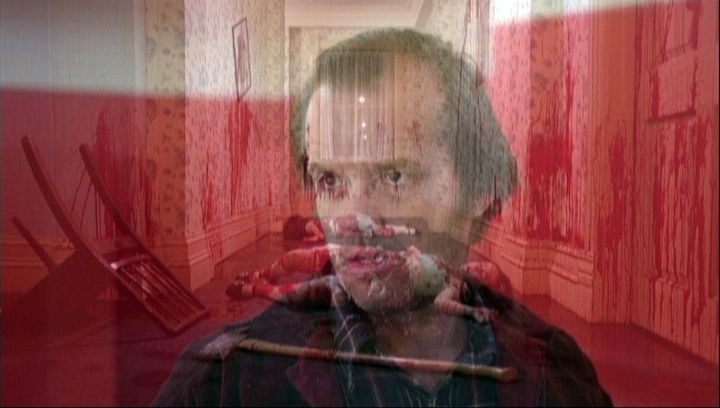
Room 237 (2012).
DB here:
Rodney Ascher?s Room 237 gathers the thoughts of five people concerning the deeper, or wider, or just awesomer meanings evoked by Stanley Kubrick?s The Shining. Those thoughts will strike many viewers as fairly far out there. Me, not so much.
?
Over the top
Room 237?adroitly blends several documentary genres. It recalls Cinemania and Ringers in its investigation of fan cultures. But instead of focusing on the personalities and lifestyles of the fans, Ascher concentrates on their readings of the movie. We never see the commentators. In this respect, it evokes the newly emerged genre of video essays as practiced by Kevin B. Lee and Matt Zoller Seitz. Yet it doesn?t offer itself as an earnest contribution to the critical conversation because Ascher freely intercuts stills and shots from other films, often to ironic effect.
In all, his film has the quizzical, gonzo flavor of an Errol Morris movie, minus the talking heads. But Morris is as interested in people as he is in their ideas. Ascher is interested in the ideas, and the way they swarm over and burrow into a film we thought we knew.
So he performs the sort of surgery more appropriate to the Zapruder footage. In the boldest test of cinematic Fair Use I?ve ever seen, a great many clips from the Warner Bros. release are run, slowed, halted, backed up, blown up, and overwritten as support for the interviewees? claims. Ascher never tries to counter their arguments; at times he supplements them with extra evidence.
The results seem, to many, at best far-fetched and at worst (or best, from an entertainment standpoint), wacko. One of Ascher?s interviewees believes that The Shining is a denunciation of the genocidal destruction of Native Americans. Another takes the film as an exploration of the Theseus myth. Another believes that the film makes references to the Holocaust. Another finds a welter of subliminal imagery pointing to ?a dark sexual fantasy.? Another sees the film as Kubrick?s apologia for staging the faked footage of the Apollo 11 moon landing.
Are these interpretations silly? Having spent forty-some years teaching film in a university, I found much of them pretty familiar. Some of the specifics were startling, but I?ve encountered interpretations in student papers, scholarly journals, and conference panels that had a lot of similarities.
If you think that this just proves that all film interpretation is ridiculous, you can stop reading now.
Because most film enthusiasts think that at least some movies need interpreting. We assume that like artists in other media, some writers and directors are using their medium to transmit or suggest meanings. And if a movie doesn?t express its makers? ideas, perhaps it can still bear the traces of ideas out there in the culture. This ?reflectionist? idea, tremendously popular among both journalists and academics, allows us to interpret even escapist fare.
Our interpretive itch has been around for a long time. Centuries of commentary have accrued around the Bible, the Torah, the Talmud, the Koran, and other texts deemed sacred. Secular texts, from Homeric epics to last month?s bestseller, have been scoured for hidden meanings too. The search hasn?t just been confined to literature, of course. An entire school of art history, called iconology, has devoted itself to deciphering objects, compositions, and other features of paintings. Even musical pieces without verbal texts have been ?read.?
If at least some movies need interpreting, The Shining would seem to be a prime candidate. The film creates many questions about the reality of what we see and hear, and it seems to point toward regions?larger??than its central tale of terror. The director was one of the most ambitious filmmakers of the twentieth century, a film artist who could use a genre-based project like the famously puzzling 2001: A Space Odyssey (1968) to convey ideas about the place of human history in the cosmos. Why couldn?t he do the same thing with a Stephen King horror novel?
What?s wrong, then, with the five critics? readings? Why do many viewers find them strained and forced, even loopy? One of the many virtues of Room 237 is that it forces us to ask: What do we do when we interpret movies? What makes one film interpretation plausible and another not? Who gets to say? What historical factors lead ordinary viewers to launch this sort of scrutiny?
?
All in the family
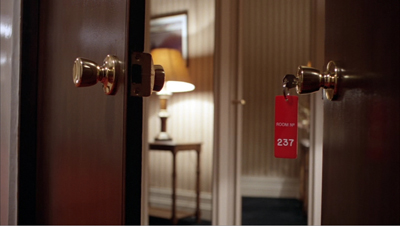
We all grant that movies have conventions. In an action picture, the bad guys have extraordinarily bad aim, except when it comes to winging the hero or plugging his best friend. Similarly, film criticism relies on a batch of conventions about what things to look for and how they should be talked about. No quickie film review, for instance, is complete without discussing acting.
Interpretation, a central activity of film criticism, has its conventions as well, and the Room 237 interviewees make some moves that are common to interpretation in academe and elsewhere. For one thing, they assume that The Shining is more than a standard-issue horror movie. Most cinephile and academic critics would agree that we have to go beyond this movie?s literal level.
Some of the Room 237ers? conclusions echo critically respectable interpretations already out there. One idea held by other critics is that the film is to some degree a parody or critique of horror conventions. Another is the conviction that the film says something about the repression of the Native American population. The Overlook Hotel is built on tribal burial grounds, a history that hints an earlier, oppressed America returning to avenge a great wrong.
Other Room 237 interpretations don?t show up in the mainstream critical literature, but they aren?t unknown in wider traditions of interpretation. Take numerology. Some interpreters of Biblical scripture find multiples of seven to be of divine significance, and so does the Holocaust advocate in Ascher?s film. According to him, the novel Lolita, which Kubrick adapted, makes 42 a symbol of fate. In The Shining, it becomes a symbol of ?danger and malevolence and disaster.? Why? Multiply 2 x 3 x7 and you get 42. Danny wears a jersey with the number 42, there are at one point 42 vehicles in the hotel parking lot, and 1942 is the year in which Hitler launched the Final Solution.
Similarly, anagrams aren?t unknown in some interpretive traditions. Scholars have claimed to find in Shakespeare?s plays encoded references to the real author (Marlowe or Francis Bacon or the Earl of Oxford). Ferdinand de Saussure, one of the founders of modern linguistics, whiled away his later years with detecting anagrams in Latin poetry. Joining up with this method, the interviewee who sees The Shining as an apology for faking the Apollo landing rearranges the letters on the room key to spell out MOON ROOM. And the moon, says the critic, is 237,000 miles from our earth.
I grant you that such cabalistic maneuvers aren?t common in film criticism. But plenty of others on display in Room 237?use the same reasoning routines that we find in consensus critical writing.
What do I mean by reasoning routines? When we interpret a movie, we?re making inferences based on discrete cues we detect in the film. What cues we pick out and what inferences we draw vary a lot, but the process of inference making tends to follow certain conventions. ?c
Consider the claim that Kubrick is warning that we shouldn?t expect a conventional horror film. A more mainstream critic would point to the flamboyant performance of Jack Nicholson, at once grotesque, comic, and ominous. This would seem to be a strong ensemble of cues asking us not to take the film straight, and perhaps implying that it?s a send-up, in a grim register, of its genre. But none of our 237ers mention this cue as a basis for their interpretation.
Instead, they scan the setting for disparities. The hotel?s architectural features sometimes differ from one shot to another. A chair is present in one reverse shot of Jack, but in the next reverse shot, it?s gone. The hotel geography can?t be plotted consistently. Moreover, one of Wendy?s visions during her desperate flight through the corridors at the climax invokes the clich?s of ordinary shockers: dust, cobwebs, and skeletons?all the paraphernalia that the film has studiously avoided up to this point. These anomalies encourage the interpreter to see the film as parodying typical horror movies. The 237 critics are picking out cues less obvious, they would say, than Nicholson?s over-the-top acting.
?
Making meaning, or making up meanings?
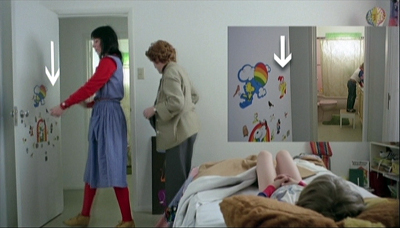
Ascher?s interviewees don?t always go for minute cues. They focus as well on many items that conventionally invite symbolic interpretation. Mirrors signal any sort of reversal, such as Danny?s backward steps through the maze or the film?s symmetrical beginning and ending. Something open?a door, a character?s eyes?suggests knowledge and acceptance; something closed, like elevator doors, suggests repression. If a character enters a space, that space can be taken as a projection of the character?s mental state, as when Danny nears his parents? bedroom and gets into ?his parents? headspace,? as one 237 critic puts it. Another commentator suggests that Jack?s job interview at the beginning of the film might be entirely his hallucination, a question raised by academic critics as well. Such speculations on the border between the subjective and objective are commonplace in discussions of horror, fantasy, and that in-between register known as the fantastic.
Puns are another time-tested inferential move. You can find a cue in the mise-en-scene and then ?read? it with a verbal analogy. Snow White?s Dopey on Danny?s door suggests that the boy doesn?t yet realize what?s going on; but when the dwarf disappears, Danny is no longer ?dopey?. A crushed Volkswagen stands for Kubrick?s telling King that his artistic ?vehicle? has obliterated the novelist?s original ?vehicle.? Abstract patterns in carpeting become Rorschach tests: Are those shapes mazes? Phalluses? Wombs? NASA launching pads? Mainstream critics might not fasten on these particular cues, but many wouldn?t resist the urge to find puns. After all, even Freud interpreted a dream in which his patient got kissed in a car as exhibiting ?auto-eroticism.?
The Room 237 critics, following tradition, let the cues and inferences lead them to what I call both referential and implicit meanings. Referential meanings involve concrete people, places, things, or events. Spielberg?s Lincoln refers to a specific historical context and people and events in it. Implicit meaning is more abstract and is something we might expect to be intended by the filmmaker. So, for instance, Lincoln could be interpreted as about the necessary mixture of principle and expediency in politics; to achieve virtuous policies, you may need to cut moral corners.
The 237er make use of different degrees of referential meaning. The Shining makes clear references to the Native American motif, not only in the hotel?s d?cor but the manager?s line of dialogue indicating that the building rests on burial grounds. That line is a rather explicit cue, and one that many non-237 critics have taken up. In a similar vein are the mythological references; both Juli Kearns in the film and several academic critics have discussed the the maze/ labyrinth imagery as citing the legend of the Minotaur.
There are more roundabout cues to inferences about the Holocaust. Kubrick might have included a photo of Nazis or Prussian generals in the Overlook?s Gold Room salon, but he didn?t. So the critic defending the Holocaust reading has to look for what we might call ?hidden references??the numerology we?ve already seen, along with the German-made typewriter on Jack?s desk, which is an Adler (?eagle,? symbol of Nazism). There?s also a dissolve that, according to another critic, gives Jack a Hitler mustache.
The Room 237 critics gesture toward implicit meanings too. The Playgirl magazine that Jack is reading when he waits in the lobby suggests that troubled sexuality is at the center of this maze?a suggestion made more explicit in the fateful Room 237, where a beautiful woman, upon embracing Jack, turns into a haggard zombie. The references to both the North American and German genocides suggest the film induces us to reflect on the cruelty of those events. More broadly, one critic believes that the film has far-reaching thematic import: The Shining is about ?pastness? itself, about coming to terms with history.
To be convincing, though, an interpretation can?t merely take a one-off cue to make references or evoke themes. What really matters are patterns.
?
Patterns of associations
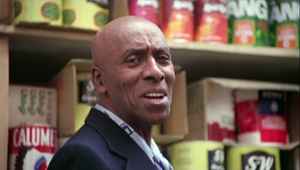 ? ? ?
? ? ?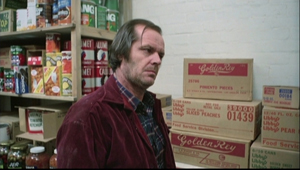
Interpreters typically gather cues into patterns and then use them to bear thematic meanings. One instance of this maneuver comes early on in?Room 237, when Bill Blakemore, proponent of the Native American genocide hypothesis, is attracted to a lone Calumet baking-powder tin, turned toward us on a shelf. Not only does the label show a tribal chief, but the plainness of presentation emphasizes the original meaning of calumet, the tobacco pipe used in Amerindian peace brokering. But that might be a one-off occurrence. Later, however, other Calumet tins are massed on another shelf?but turned from us. It?s not enough that the can has now been repeated. The change, Blakemore proposes, indicates that the original, straight-on image has turned into something hidden and dishonest?the destruction of the tribal population.The spatial opposition frontal/oblique has been made to bear a thematic difference between honesty and betrayal.
A similar duality, with a punning tint, is raised when Kearns traces how she came up with the Minotaur hypothesis. She points out that a skier poster (to her eyes, resembling a Minotaur?s silhouette) stands opposite a rodeo poster (?Bull-man versus cow-boy?). The poster led her to realize that the Minotaur sits at the center of a cluster of images that recur in the film. He presides over the labyrinth that is the hotel, which, Kearns argues, has an impossible geography, while the intertwined logo of the Gold Room recalls Theseus?s thread. In his alternate identity Asterios, the Minotaur suggests stars, which in turn suggest movie stars (who, we?re told, have stayed at the Overlook). The ski poster reads ?Monarch,? which in a sense the Minotaur is, and we learn that royalty have visited the hotel too.
Or take the Holocaust reading. Apart from the fateful 42 motif, the Adler typewriter does other work. Its name (?eagle?) evokes the emblem of the Reich, but an eagle is also a prominent American icon. So the critic adds that Kubrick always uses an eagle to symbolize state power. How then to link it to Germany? The typewriter, as a machine, evokes the bureaucratic efficiency of Hitler?s mass deportations and executions. To back this up, the critic recalls Schindler?s List, in which typewriters figure extensively.
Such expanding clusters are common in interpretive activity because artworks often ask us to tease out associations. Early in The Shining, the Torrance family talks about the Donner party. We?re invited to see the reference as conjuring up slaughter, isolation in a snowbound environment, and the collapse of civilized restraints?just what the film will give us. Critics of all stripes track the dynamic of the artwork by creating associative patterns out of repeated elements. When Wendy and Danny watch the film Summer of ?42 on TV, it?s not the 42 that attracts the distinguished academic critic James Naremore. He links the embedded film about the sexual attraction between an older woman and a younger man to the moment when Danny runs out of the maze and kisses Wendy on the lips. These moments are part of a constellation of images and events marking the film as ?flagrantly Oedipal,? in that it presents with the son?s struggle against the hostile father. Naremore is able to build on this cluster to suggest that the film is unusual in rehearsing different, non-Freudian aspects of the Oedipus myth.
You might object that, unlike Naremore and other professionals, the critics in Room 237 build up associations from their personal experiences rather than what?s objectively on the screen. Blakemore says that he noticed the Calumet label because he grew up in Chicago near the Calumet River and as a child he gathered Indian pottery. Yet the conventions of mainstream movie reviewing allow critics to look inward too. Jonathan Rosenbaum opens his piece on James Benning?s El Valley Centro:
About halfway through I found myself, to my surprise, thinking about Joseph Cornell?s boxes, those surrealist constructions teeming with fantasy and magic?dreamlike enclosures that make it seem appropriate that Cornell lived most of his life on a street in Queens called Utopia Parkway.
The only difference between Rosenbaum?s associational links and Blakemore?s would seem to be the cultural level of the references. Why should the amateur not be allowed to import less arcane personal associations into an interpretation?
Finally, you might object that the Room 237 critics are too focused on trying to infer Kubrick?s intentions. Kubrick had wanted to make a film on the Holocaust at some point; he read Raul Hilberg?s Destruction of the European Jews and corresponded with the author. Kubrick also read Bruno Bettelheim?s Uses of Enchantment, a Freudian explanation of fairy tales; hence the Hansel and Gretel and Big Bad Wolf references in the film. One Room 237 critic says that Kubrick was bored after making Barry Lyndon and wanted to make a movie that reinvented cinema. Yet, again, journalistic critics commonly make assumptions about what the filmmaker is up to. Even academics, trained to believe in ?the intentional fallacy? and to ?never trust the teller, trust the tale,? can indulge in hypotheses about directorial purpose. In explaining the eccentricities of the lead performance, Naremore notes that in interviews, Nicholson reported that Kubrick told him that ?real? performances aren?t always interesting.
?
Tie me up! Tie me down!
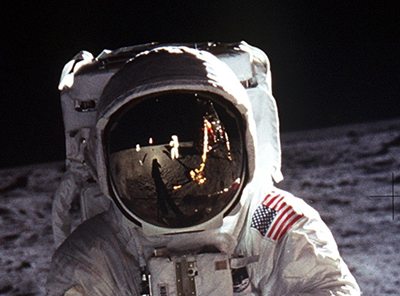
Apollo 11 moon landing, July 1969.
For mainstream film criticism, however, the patterns and the significance-laden associations they trigger have to be constrained somehow. Not everything is relevant to the implicit meanings of the film. This condition, I think, shows the real gap between the 237ers and the pros. One interviewee?s enthusiasm marks this difference: Kubrick, he says, is ?thinking about the implications of everything that exists.? No mainstream critic would dare make this move.
What are the constraints on interpretation within the community of publishing critics, either journalistic or academic? Here are some common ones.
Salience: The patterns and associations are more plausible if they?re readily detectable? if not at first, then on subsequent viewings. The case gets stronger if the motif is reiterated along many channels?image, dialogue, music, sound effects, written language. The Native-American genocide association is moderately salient, present in both items of d?cor and in Ullman?s line about the burial grounds. Accordingly, many viewers have picked up on it. On the other hand, even repeated viewings don?t help us (me, at least) to identify the magazine as?Playgirl.
Coherence: The patterns and associations are more plausible if they?re related functionally to the narrative?not just to single moments but to its overall development. Most critics writing about The Shining assume that it?s centrally about the disintegration of the family. They have gone on to relate this to the way that the delusions of patriarchy subject women and children to its control. (That common academic trope of ?the crisis of masculinity? hovers nearby.) This thematic thrust can be traced scene by scene, and the motifs of fairy tales, American history, and the Minotaur can blend with specific plot twists and character presentation. Some of the Room 237 critics? readings mesh with the arc of the narrative, but many, such as certain overlays during dissolves, seem unmotivated by narrative factors.
Congruence with other relevant artworks: The patterns and associations gain plausibility if they can seem congruent with other works by the same artist or in the same genre. For example, the uncertainty about whether Jack is imagining the Gold Room or whether it?s a genuine supernatural entity is characteristic of horror/ fantasy films. Here the 237ers are more in line with their mainstream colleagues. The unresolved ending, leaving us with a puzzle about whether Jack himself is a reincarnation of someone from the past, isn?t out of keeping with the ending of 2001. The room 237 itself, one of Ascher?s critics suggests, is a bit like the old man?s bedroom and the space pod in the earlier film.
Appeal to authorial intention: The critic?s case gains plausibility if people having significant input into the work claim the patterns and associations were deliberately put there. While rewatching The Shining, Nicole Kidman remarked of Kubrick:
?He always said that you had to make sure the audience understood key pieces of information to follow the story, and that to do that you had to repeat it several times, but without being too obvious about it,? Ms. Kidman said. ?Here, in this scene, look at how there is this rack of knives hanging in the background over the boy?s head. It?s very ominous, all of these knives poised over his head. And it?s important because it not only shows that the boy is in danger, but one of those very knives is used later in the story when Wendy takes it to protect herself from her husband.?
Most mainstream critics would, I think, find that Kidman?s inference rings true. It picks up a fairly salient cue, it invokes a pattern involving the knives, and it squares with the unfolding of the narrative. She reports that Kubrick understood the need for patterns to have salience, and it seems quite likely ?that he was the sort of artist to use pictorial prefigurations like this. Note, though, that this shot exemplifies function-driven dramaturgy?foreshadowing?not thematic interpretation.
By contrast, consider the Room 237 critic who takes The Shining to be Kubrick?s apology to his wife for staging the fake Apollo 11 moon landing. As Ascher presents the case, it involves a long chain of causation. It starts from the claim that, whether or not NASA actually sent a crew to the moon, the landing that the public saw was staged. The project needed front-screen projection. Kubrick was the master of those special effects. He agreed to help film the fake landing. Later he felt guilt for it. So by making a film about a husband/wife conflict, Kubrick confesses to his mistake. This backstory would gain a lot of plausibility if a NASA staffer or one of Kubrick?s crew came forward to support any part of it, in the way Kidman offers testimony about Kubrick?s working methods. It would be even better if the Apollo tale could be tied to the specifics of the unfolding narrative. And it would be best if the interpretation of this film didn?t depend on a (questionable) interpretation of another film?the Apollo 11 footage.
The Apollo 11 argument illustrates the risk of appeals to intention: they tend to substitute causal explanations for functional ones. That is, they tend to look for how something got into the film rather than what it?s doing in the film. But that?s a risk that professional critics run as well when they appeal to intention. The problem is just more apparent when the causal story that?s put forward seems tenuous.
I?ve argued that the cue-inference method and the use of association to create patterns aiming at referential and implicit meanings are involved in all interpretations, staid or unorthodox. But the constraints I?ve just sketched aren?t so fundamental to interpretation as such. They typify the established critical institution, which includes journalism high and low, belles-lettres (e.g., The New York Review of Books), specialized cinephilia (eg., Cinema Scope), and academic writing.
Not everybody belongs to that institution. There are other arenas of film criticism, and there?s no mandate that discussion in those realms adhere to the constraints urged by professional criticism. Some readers prefer to muse on barely perceptible patterns, incoherence, unlimited association, and relatively unrestrained speculations about Kubrick?s mental processes. Fans like to think and talk about their love, and anything that gives them the occasion is welcome, no matter what any establishment thinks. To a considerable extent, Ascher?s film documents the habits of folk interpretation.
?
Some precedents
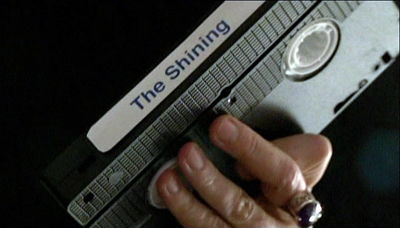
But why now? Why do amateur critics today launch these ambitious expeditions? The short answer, as so often, would be: Because they can. As Juli Kearns points out, it thanks to VHS, then DVD, that she was able to scrutinize?The Shining. Home video has allowed us, including all the obsessed among us, to halt and replay a movie ad infinitum?a process that Ascher?s own film freely indulges in. I think, though, that there are other historical factors that impel fans to dig ever deeper into the movies they love.
Most obviously, there?s the rise of the puzzle film, the movie that litters its landscape with hints of half-buried meanings. The vogue for this began, I suppose, in the late 1990s with films like Memento, Magnolia, and Primer. Even then, though, there were different constructive options. Primer called out for re-watching because much of its plot was obscure on a single pass; you had to examine it closely to figure out its basic architecture. By contrast, Memento?s principle of reverse chronology was evident on first viewing. I suspect that most viewers, like me, studied the film to pick up the finer points of its form and to try to disambiguate the Sammy Jankis plotline. Still different was Magnolia, with a perfectly comprehensible plot that planted a Biblical citation in its mise-en-scene. In this case, the extra stuff suggested a thematic level that might not be apparent otherwise.
Some critics have objected that the Room 237 critics turn Kubrick?s film into a mere puzzle movie, the implication being that puzzle movies are inferior forms of cinema. Yet I don?t see a good reason to scorn them. Assuming that films often solicit our cognitive capacities, I don?t see why artists shouldn?t ask us to exercise them. Cinema takes many shapes, and one critic?s puzzle (?Rosebud,? ?Keyser S?ze?) is another critic?s mystery. Some artworks throb with passion; some are more intellectual and austere. There is Mahler, and there is Webern.?Even artworks with a lyrical or emotional dimension ask for decipherment and meditation too. Dante explained to his patron Can Grande della Scala that he had laid layers of non-literal meanings into The Divine Comedy. The poem, he explains, is??polysemous.? Its meanings are to be grasped and pondered upon in the manner of Scripture.
Long before puzzle movies came into fashion, literary modernism had assigned readers this sort of homework. The idea of loading every rift with ore was taken quite seriously by T. S. Eliot, who supplied footnotes to The Waste Land.?Could you really hope to understand it without reading Jesse Weston?s From Ritual to Romance? James Joyce built so many layers into Ulysses that he had to take a critic aside and explain them to him, so the critic could then publish a guidebook to the novel. Finnegans Wake is supersaturated with references, puns, and esoteric meanings. If ever an artwork needed decoding, this is it. One of the earliest scholarly studies is called A Skeleton Key to Finnegans Wake.
In cinema, Peter Greenaway?s Tulse Luper series seems to be his bid for Joycean stature. More successful has been Godard, who in his mid-1960s films created an aesthetics of dispersal, a display of citational pyrotechnics that reaches its apogee in the Histoires du cin?ma. Surely this suite of films has engaged many critics in a process akin to puzzle-solving. More to our point today, we might see Kubrick?s films, especially 2001, as bringing aspects of high modernism into mainstream cinematic genres. We can hardly be surprised that after courting many interpretations of 2001 (whose very subtitle includes a citation of a classic literary text), this director might be posing us similar tasks in a horror film.
Something else besides the rise of the puzzle film and high-modernist polysemy is probably responsible for the rise of this sort of fan dissection. Throughout history storytellers have experimented with creating what we might call richly realized worlds. Naturalist literature describes fine details of the writers? society at the time, while Gulliver?s Travels and Looking Backward take us into alternative realms. The rise of fantasy and science-fiction literature has led readers to demand to know the history, lore, and furnishings of the imaginary places they visit. The?Lord of the Rings saga, part of what Tolkien called his legendarium, is the obvious prototype, but the tendency to fill every niche of imaginary worlds is there in the Star Wars and Marvel universes too.
Once fans have become accustomed to raking every frame for clues about the plumbing system of the Millennium Falcon, they are going to expect an equal density in ambitious works in other genres. But not all films, or even all genres. I suspect that we won?t get the equivalent of Room 237 for My Fair Lady or Dinner at Eight. Combined with the intrinsic fascination of The Shining, Kubrick?s well-publicized concern for detail in the futuristic 2001 and A Clockwork Orange leads us to?expect that a film centered on the enclosed world of the Overlook would yield bounty when scrutinized.
Finally, I should note that the seeming capriciousness of the Room 237 readers has a counterpart in one strain of academic interpretation. Borrowing from both Surrealism and a post-Structuralist concern for a ?free play of the signifier,? Tom Conley and Robert B. Ray have practiced a criticism that yields results strikingly similar to the work of Ascher?s interviewees. Ray cultivates free association, as when he puns on characters? names, and Conley has been known to find, as one Room 237 critic does, significant images in cloud formations.
The only major difference is that these academics typically discount an appeal to the filmmakers? intentions: that move would inhibit the critic?s free-ranging imagination. Once in a while, the Room 237 critics follow suit on this front. They withdraw from attempts to anchor their readings in Kubrick?s life, thought, and personality. One who appealed to intentions early in the film has abandoned them by the end, and another frankly admits: ?One can always argue that Kubrick had only some or even none of these [interpretations] in mind, but we all know from postmodern film criticism that author intent is only part of the story of any work of art.?
One of Ascher?s most engrossing final sequences shows John Fell Ryan?s attempt to run The Shining forward and backward at the same time, superimposing them to create startling new images like the one that surmounts today?s entry. Folding the film over onto itself is in the spirit of Conley and Ray?s work, I think. The gesture hearkens back to that ?irrational enlargement? of films that the Surrealists sought when they dropped in on the middle of one movie, stayed a little while, and then hurried out to slip into another. (They would have loved multiplexes.) Again, the apparently far-fetched meaning-making strategies of our amateur critics turn out to have some kin in the academic establishment and in the history of artistic culture. And Ryan?s chuckle about the cool juxtapositions
?
I?ve made Room 237 more solemn than it is. It?s a pleasurable and provocative piece of work. It too would be worth interpreting, but I haven?t tried that here. I?ve used it as a kind of AV demonstration. It handily illustrates how interpreting a movie involves certain informal reasoning routines shared by ?amateur? and ?professional? critics. The differences between the two camps depend largely on what cues the critic fastens on in the film, what associational patterns the critic builds up, and how strongly the critic subscribes to the professional constraints on inferences.
Whether the cues, the patterns, and the inferences based on them seem plausible depends on what particular critical institutions have deemed worthwhile. Claims that won?t fly in mainstream or specialized cinephile publications can flourish in fandom. The purposes and commitments of these institutions may sometimes overlap, but we shouldn?t expect them to.
My account of these critics? interpretations is drawn wholly from Ascher?s film. All of the interviewees have published more detailed arguments for their views. Bill Blakemore?s thesis about the film?s portrayal of Amerindian genocide is here. Go here for Juli Kearns? writings on various aspects of Kubrick?s film. Jay Weidner?s thoughts are here. Geoffrey Cocks? thesis is laid out in his book The Wolf at the Door: Stanley Kubrick, History, and the Holocaust (2004). Jay Fell Ryan discusses and updates his observations in this tumblr site. See also Ryan?s reflections after seeing Room 237.
There seems little doubt that musical texts featuring a verbal text or carrying a program that the composer has sanctioned (like Tyl Eulenspiegel?s Merry Pranks) can be interpreted in the manner of a novel or painting. Even non-programmatic works without texts have been subjected to interpretation. A still controversial example is Ian MacDonald?s 1990 The New Shostakovich, which launches detailed interpretations of hidden meanings in the composer?s work. For critiques, see Richard Taruskin?s articles in Shostakovich in Context, ed. Rosamund Bartlett, and Shostakovich Studies, ed. David Fanning.
The standard book on secret codes in the Bard is William F. Friedman and Elizabeth S. Friedman, The Shakespearian Ciphers Examined. On Saussure?s search for Latin epigrams, see Jean Starobinski, Words upon Words, trans. Olivia Emmet and ?The Two Saussures,? Semiotexte 1, 2 (Fall 1974).
James Naremore?s wide-ranging interpretation of The Shining is in On Kubrick. Dennis Bingham provides a detailed history of journalistic and academic interpretations of Kubrick?s film in ?The Displaced Auteur: A Reception History of The Shining,? in Perspectives on Stanley Kubrick, ed. Mario Falsetto, 284-306.
Shane Carruth explains that the puzzle aspect of Primer involves only making chronological sense of the plot, which avoids redundancy to an unusual degree.
It?s just that the way the narrative is constructed, I can see how when the story asks you to pull the threads together that?s probably going to happen where threads are pulled together wrong. I definitely didn?t set up this narrative to be open to interpretation. I mean, except for a few things. For the most part, the information is in there to have a very concrete answer as to what is happening in the narrative.
Some critics have worried that Ascher?s film gives viewers an impoverished view of what film criticism is. See for instance Girish Shambu?s comments here. For my part, I doubt that viewers come away believing that the views of these interviewees are typical of criticism as practiced in the mainstream. Nor do I see why Ascher?s movie needs the bigger dose of Theory that Girish prescribes. For my take on Theory (as opposed to theories and theorizing), see the book I edited with No?l Carroll, Post-Theory:Reconstructing Film Studies.
There?s another issue. Like Girish, ?Jonathan Rosenbaum reprimands the 237 critics for turning The Shining into a puzzle movie.
One way of removing the threat and challenge of art is reducing it to a form of problem-solving that believes in single, Eureka-style solutions. If works of art are perceived as safes to be cracked or as locks that open only to skeleton keys, their expressive powers are virtually limited to banal pronouncements of overt or covert meanings.
I?ve already proposed that a problem-solving approach need not reduce the artwork to a bloodless abstraction. (By the way, I don?t see puzzle-solving and problem-solving as quite the same; I?d say that a puzzle is a particular kind of problem.) But perhaps we should read Jonathan?s first sentence as objecting only to problem-solving approaches that posit ?single, Eureka-style solutions.? That would rescue Eliot and Joyce, perhaps, although realizing that Ulysses is a remapping of The Odyssey is something close to a Big Solution to the book.
In any case, ?it?s not clear that the 237ers are absolute in their arguments, at least not all the time. The last section of the film chronicles them backing away from their own machinery, confessing that there are dimensions to the film that they haven?t yet grasped, acknowledging that it remains elusive, mysterious, confusing, and, as Dante or a modern theorist might say, polysemous. Moreover, it seems clear that these critics all acknowledge the ?expressive powers? of The Shining. They all testify to having been deeply shaken by it; that?s what fuels their urge to probe it. They just claim, like many critics, that the film?s significance extends beyond the visceral and emotional arousal it creates.
On richly realized worlds:?J. R. R. Tolkien chose the Latin term?legendarium?to characterize the entire body of his writings set on the fictional planet Arda, (primarily on the continent of Middle-earth) and the universe in which it exists. The legendarium includes works published during his lifetime,?The Hobbit,?The Lord of the Rings, and?The Adventures of Tom Bombadil, as well as posthumous publications edited by his son Christopher,?The Silmarillion, ?The Quest of Erebor,? and?The Children of Hurin. Not strictly speaking part of the legendarium but closely related to it are the numerous drafts published as?Unfinished Tales?and the twelve-volume ?The History of Middle-earth? series, as well as previously unpublished drawings and maps collected by Wayne Hammond and Christina Scull in?J. R. R. Tolkien: Artist & Illustrator?and?The Art of The Hobbit. (Kristin wrote this paragraph, as you can probably tell.)
For samples of the post-Structuralist interpretative modes I mention, see Robert B. Ray, The Avant-Garde Finds Andy Hardy, and Tom Conley, Film Hieroglyphs.
In another entry I suggest that interpretation is only one critical activity we might pursue. On contemporary Hollywood cinema?s penchant for puzzle films and richly realized worlds, see my book The Way Hollywood Tells It. In?Making Meaning: Inference and Rhetoric in the Interpretation of Cinema I try to show that?just as we can analyze the conventions of a genre or mode of filmmaking, we can analyze the conventions of film talk. It?s one thing that I think a poetics of cinema brings to the table: an effort to disclose what principles shape a critical argument. As for my own tastes, I value consistency, coherence, constrained ascriptions of intention, and historical plausibility in interpretations. But in my own efforts, I favor analyzing films? functional dynamics over hunting down hidden meanings.
P.S. 7 April: Thanks to David Kilmer for a corrected quotation!

The Simpsons: Tree House of Horror V: The Shinning (1994).
This entry was posted on Sunday | April 7, 2013 at 5:10 pm and is filed under Documentary film, Film comments, Film criticism, Film theory. Responses are currently closed, but you can trackback from your own site.
Source: http://www.davidbordwell.net/blog/2013/04/07/all-play-and-no-work-room-237/
wal mart happy thanksgiving Macys Thanksgiving Day Parade 2012 Turkey Cooking Times Butterball mashed potatoes Apple Black Friday
 ?open printable version
?open printable version
কোন মন্তব্য নেই:
একটি মন্তব্য পোস্ট করুন